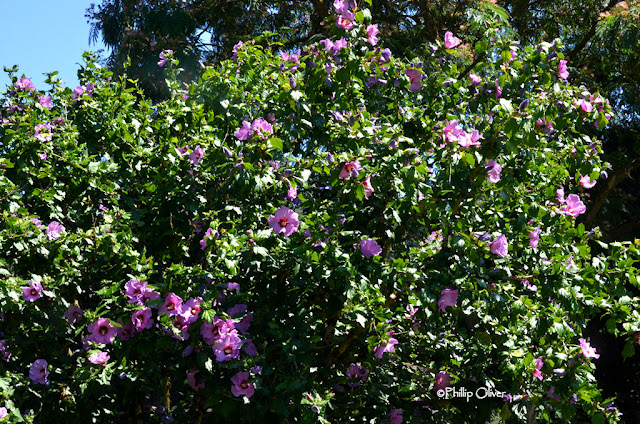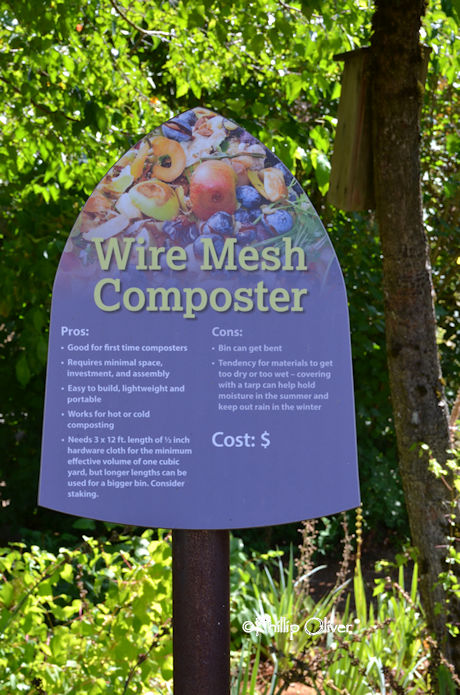I revisited the NatureScaping Wildlife Botanical Gardens in Brush Prairie (about 15 minutes from our house) last week. Michael and I had been there on a local garden tour two years ago but there was a music festival going on so we did not stay that long. I was alone on my trip back and it was a very quiet morning to see the gardens.
 |
| Chinese Fringe Tree (Chionanthus retusus) |
There are three acres of garden rooms, all designed to show people how they can create wildlife sanctuaries in their own gardens. This is a good place to see native plants and mature trees in action. Almost all of the plants I saw were labeled.
One of the first trees I saw was Chionanthus retusus (Chinese Fringe Tree), a tree that you rarely see here. I have been contemplating adding an American Fringe Tree (Chionanthus virginicus), similar but with showier blooms, to our garden because it was one of my favorite trees in Alabama. My gardening guru, Pam Harper, grew both trees in her Virginia garden and says that the Asian variety blooms longer. I am not sure how long the bloom is for American Fringe tree here in Washington as I have yet to see one growing anywhere. My boss at the nursery tells me that he occasionally stocks them but they rarely sell.
Another distinct Asian native that I remember vividly from my Alabama childhood was Silk Tree (Albizia julibrissin) which we called "mimosa'. The main memory that lingers with me about this tree is the one that grew at my grandmother's house. It was large and we used to climb it. One day, my sister slipped and cut her foot on it. It was scary at the time but in hindsight was probably not as serious as I imagine. I do remember a lot of blood!
Out in rural Franklin County, Alabama, these trees were quite common but then they suddenly disappeared. I suspect that one of the cold winters in the 1980s killed them off. I occasionally come across one out in the woods on my mother's property but I haven't seen a large one there since the 70s.
I have not seen many here in Washington or Oregon either but we sell them at our nursery and customers often ask for them. At the NatureScaping hummingbird garden, I glanced up to see what was providing a nice dappled shade and was awed by this beauty -
Other interesting trees and shrubs -
 |
| Silk Tree (Albizia julibrissin) |
 |
| Cockspur Hawhtorne (Crataegus crus-galli) |
 |
| Weeping Pussy Willow (Salix) |
 |
| Compact Tanyosho Pine (Pinus densiflora 'Umbraculifera Compacta') |
 |
| Arrowwood Viburnum 'Blue Muffin' (Viburnum dentatum) |
 |
Chamaecyparis pisifera 'True Blue'
|
 |
| Red Osier Dogwood (Cornus sericea) |
 |
| Ocean Spray (Holodiscus discolor) |
 |
| Himalayan Honeysuckle (Leycesteria Formosa) - I just added one of these to the garden this year. |
 |
| Variegated Elderberry (Sambucus) |
 |
| Sea Holly (Eryngium) |
 |
| Rose of Sharon (Hibiscus syriacus) and Butterfly Weed (Asclepias tuberosa) |
In addition to the beautiful gardens, there are educational display areas on composting, vegetable gardening and water-wise gardens.
Text and photos by Phillip Oliver, Dirt Therapy




















I keep meaning to visit again . It must have changed quite a bit, it's been several years .
ReplyDeleteInteresting information about composting. Thanks
ReplyDeleteThe Mimosa is becoming invasive in our area. They are discouraging people from planting it. You see it popping up here and there. My friend has one and it is quite messy too. dropping limbs etc. It is gorgeous though. I remember one in our garden when I was a child. I love seeing hummers going to those blooms. It always blooms on my birthday too. :) I have been incorporating
ReplyDeleteOOps, my comment disappeared before I finished. Gary told me something funny and I hit publish. Sorry, lost my train of thought too. It is pouring rain here. Must go watch.
ReplyDeleteThey have are a few mimosa growing around Green Lake in Seattle. I see them as I drive by every weekend. I was surprised the first time I saw them; I didn't think they would grow in the PNW, but they do.
ReplyDeleteTheir shape and leaf pattern always reminds me of the Royal poinciana, but those sadly don't grow around here.
Wire composting is an interesting idea!
I don’t remember what prompted us to buy a Chinese fringe tree, but I’m so glad we did. It’s a favorite of mine. I must admit that I’ve never seen another like it. Two thumbs up!
ReplyDeleteWell, I'm coming late to this post but after seeing the mimosa I have to comment. They are EXTREMELY invasive in my area near Gadsden, NE Alabama. They are a member of the pea family and if you ever see the vast amount of seedpods hanging after the bloom is done, you would think twice about how beautiful they are. I just cut down some in my neighbors woods after sitting on my porch seeing all the pods hanging way up high. I've had volunteers popping up all over my yard this year - not a good thing.
ReplyDelete